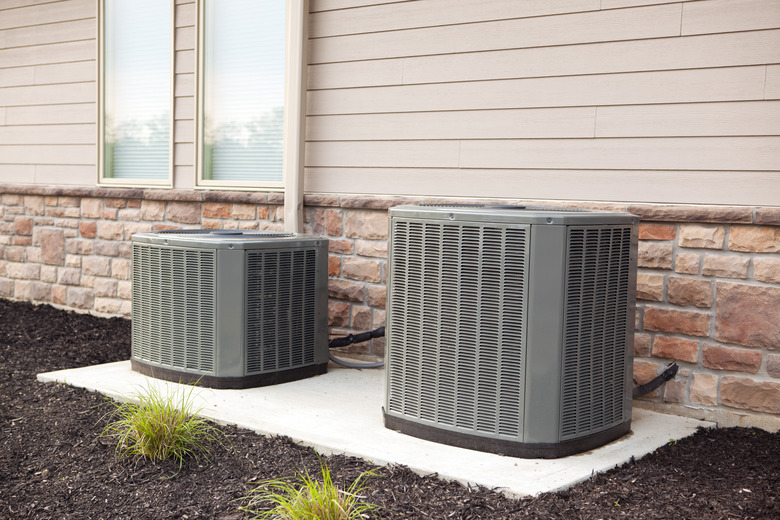Two And A Half Ton Vs. Three Ton Air Conditioner
We may receive a commission on purchases made from links.
The difference between 2.5 tons and 3 tons might not seem like much, but it can make a big difference in your air conditioning. A properly sized central air unit works efficiently and keeps your home comfortable. Your HVAC professional will help you choose the correct size, but understanding the differences between these two sizes helps you prepare if you're thinking of buying a new central air unit.
Air Conditioning Sizing
Air Conditioning Sizing
Two of the basic measurement standards for air conditioners are British thermal units (BTUs) and tons. It takes 1 ton of air to move 12,000 BTUs of heat per hour. When you shop for an air conditioner, a common starting point is to determine the number of BTUs you will require and then calculate the corresponding number of tons you need.
The general guideline is a 2.5 ton unit for a home that's 1,500 to 2,000 square feet. A 3 ton unit is ideal for a home that's 2,000 to 2,500 square feet. However, other factors might change the size you need. These things include the climate, ductwork, insulation, number of windows, shade on the home, and number of residents in your home. That's why it's best to have an HVAC professional calculate the size you need.
2.5-Ton Air Conditioner
2.5-Ton Air Conditioner
A 2.5-ton air conditioner will move 30,000 BTUs of heat per hour. You can confirm that you have a 2.5-ton air conditioner by looking at the metal manufacturer's identification plate on the back of the air conditioner. The model number will include the number 30, identifying the unit as having a 2.5-ton capacity. Residential air conditioners typically range from 1 to 5 tons. Therefore, a 2.5-ton air conditioner is about in the middle of the standard range for residential air conditioners.
3-Ton Air Conditioner
3-Ton Air Conditioner
A 3-ton air conditioner will move 36,000 BTUs of heat per hour. To confirm that you have a 3-ton unit, look for the number 36 on the metal manufacturer's identification plate on the back of the air conditioner. A 3-ton unit is a bit past the middle of the standard range for residential air conditioners.
Similarities Between Sizes
Similarities Between Sizes
Whether you decide on a 2.5-ton or a 3-ton air conditioner, you'll find a wide array of styles to select for keeping your home cool and comfortable. If you're shopping for a central air conditioning system, your choices include a single-stage or two-stage unit or a condensing air conditioner. Most window air conditioners and portable air conditioners are made from single rooms and have lower BTUs. The SEER ratings (Seasonal Energy Efficiency Rating) will also be similar, and you'll easily find models with ratings that range from 13 to 17.
Differences Between Sizes
Differences Between Sizes
The costs of the air conditioning unit and costs of cooling are the biggest differences between 2.5-ton and 3-ton units. Don't think that by going bigger you'll feel a difference in the level of cooling. Oversized units will short-cycle, which means they only run for a short time, and might struggle to remove humidity from your home. It can also put extra wear on the components.
Your decision should be based solely on the BTU capacity that you need to cool your home properly. Once you know your BTU requirements, you will have a basis for making a good decision.
Energy Cost Comparison
Energy Cost Comparison
To get an idea of the energy cost differences, let's assume the air conditioner is to be used in Atlanta, Georgia, where the average cooling hours are 1,200 for the year. Assume the air conditioner has a SEER rating of 17, and the cost per kilowatt hour charged by the utility company is 7 cents.
The math formula is as follows: air conditioner BTUs, multiplied by cooling hours, divided by SEER rating, multiplied by the cost per kilowatt hours, and divided by 1,000. As a result, the cost per year to operate the 2.5-ton air conditioner would be $148.23, and the cost per year to operate the 3-ton air conditioner would be $177.88, which is about 20 percent higher.
